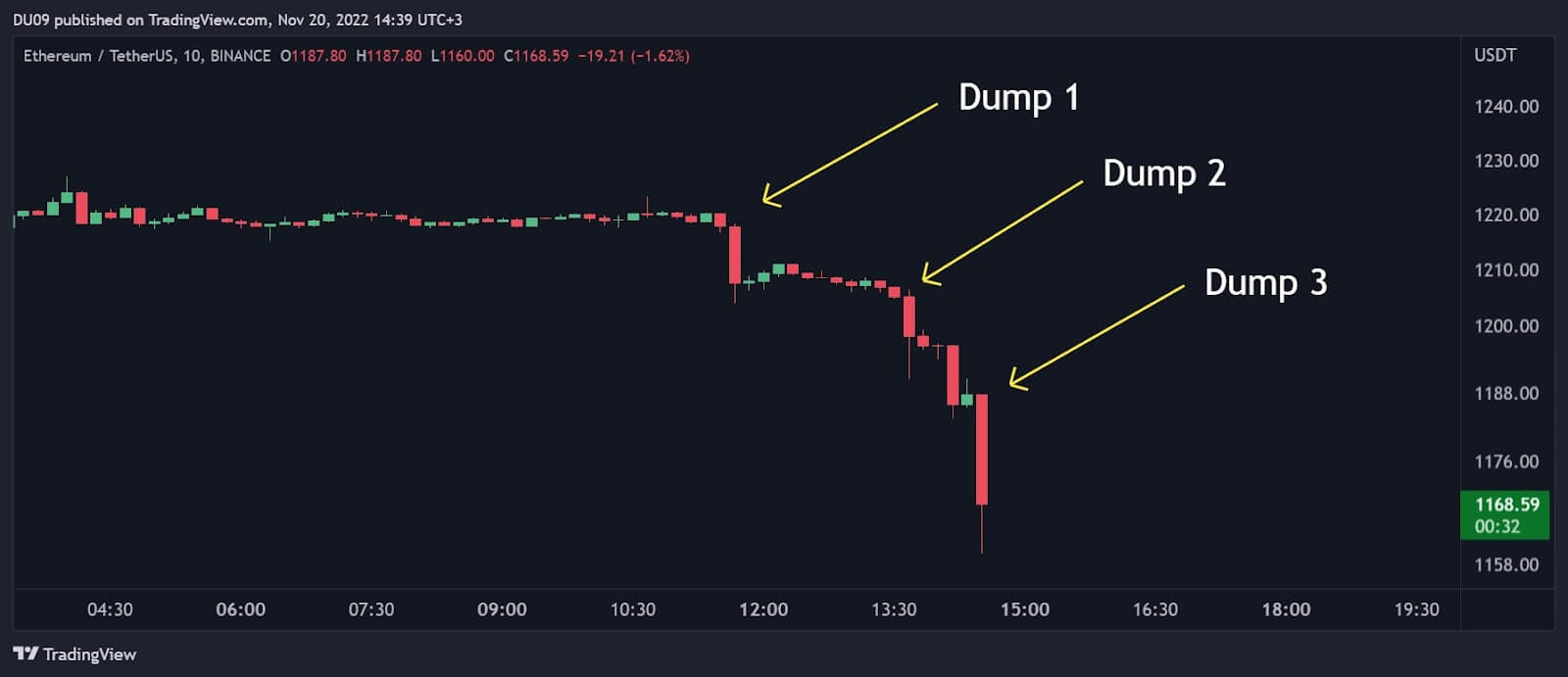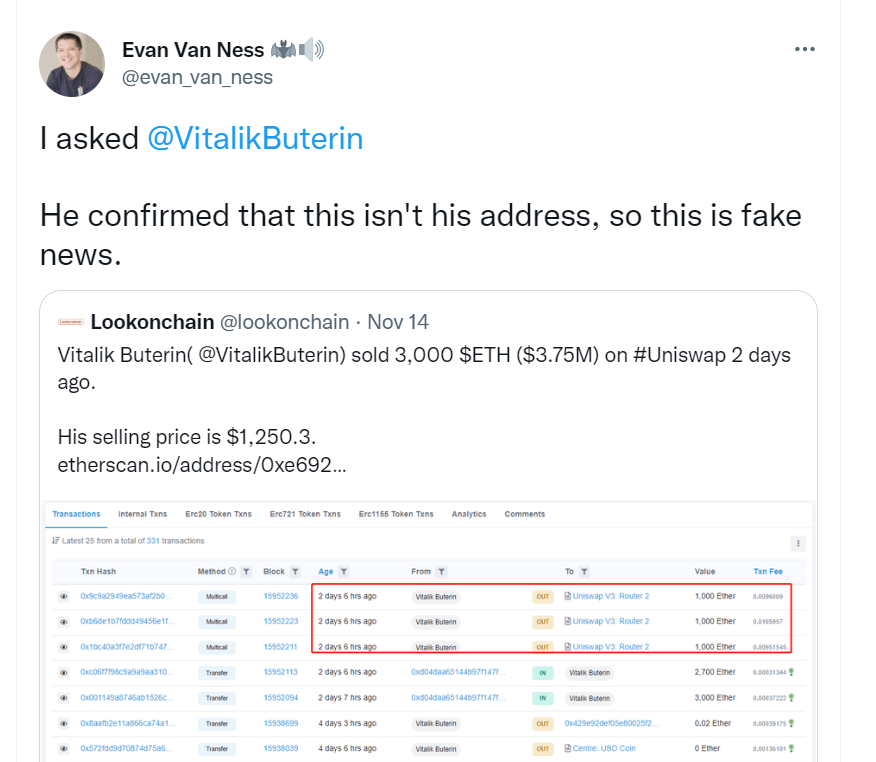
As most readers may already be aware, a further bizarre development in the FTX saga was that almost half of the coin balance in FTX was stolen by a hacker after the firm filed for bankruptcy. The estimated dollar value of the stolen coins was at least worth $447 million and while most of the loot was in altcoins, the hacker had managed to sell them for Ethereum through a series of complicated swaps done at different decentralised protocols using money laundering techniques. According to market data, the hacker had around 250,000 units of ETH after the conversion, which has made him the 27th largest ETH wallet entity in the world, inclusive of institutions and exchanges. The media has painted him as a really big threat to the price of Ethereum since he acquired his coins for basically next to nothing and as a result, would not be price sensitive unlike all other investors, which meant that he could basically keep dumping without paying any attention to how the price has fallen.
The revelation of this new twist has hit the price of Ethereum hard, dragging the second largest crypto in market cap down by almost 15% from around $1,285 to $1,103 at the point of writing, when the hacker had only started attempting to sell around 50,000 ETH on Sunday. With the hacker having another 200,000 ETH left to dump, the short-term outlook of Ethereum indeed looks bleak. However, is it as bad as it seems? Read on to find out.
Hacker Has Started Selling Ethereum
According to a user by the name of DUO9, the hacker started selling his first batch of Ethereum on Sunday, November 20, in three different waves as seen in the screen grab from his twitter post, which crashed the price of ETH from $1,230 to $1,168.

A report by Cointelegraph explained that the hacker first transferred 50,000 ETH to a new Ethereum address, which then swapped the ETH for renBTC (ERC-20 version of BTC) and bridged them to two wallets on the Bitcoin blockchain, where they were redeemed for Bitcoin and subsequently sent to crypto exchanges for sale. The estimated number of Ethereum sold during this first exercise was about 31,000 units, with another 19,000 ETH waiting in line to be exchanged for renBTC in the same way and ought to be completed by the time this article is published.
Data from crypto analytic group CertiK tracked the bridged renBTC and found that the addresses employed a money laundering technique called Peel Chain to launder the renBTC to prevent the coins from being red-flagged.
A Peel Chain is a technique used to launder a large amount of crypto through a long winded series of minor transactions. A small portion is “peeled” from the subject’s address in a low-value transfer and are then transferred to exchanges where they can be converted into fiat currency or other crypto assets without being sanctioned. While it takes a long time to dispose of his stolen Ethereum in such a way, it assures him of being able to get away from the crime and not risk having his stolen assets frozen, at least for the time being.
While the hacker’s wallet ranking has dropped 8 places from top 27 to to 35 wallet after the first 50,000 ETH were transferred out, he still has 200,000 more ETH to go and as at the time of writing, had just transferred around 195,000 of them in batches of 15,000 to the same address where he is expected to convert them into renBTC and redeem for Bitcoin in the same way he did above and eventually sell them as Bitcoin for fiat.
While he is not directly selling Ethereum into fiat, the method he uses to dispose of his Ethereum is certainly not good since any swap, no matter how complicated it is being devised, in essence, means selling Ethereum for some other token, which will still drive the price of Ethereum down. To make matters worse, using Bitcoin as a method to off-ramp into fiat would drag the price of Bitcoin down as well, which becomes a double whammy to the crypto world.
Is It a Good Idea to Short Ethereum Then?
While the hacker disposing of his ill-gotten Ethereum is certainly not a good event, all is not lost for the price of Ethereum as yet.
Ethereum whales are trying to not let this unfortunate event affect the price of Ethereum as much as they can as they have swooped in to purchase more ETH in the aftermath.
On Monday, November 21, Ethereum saw its 5th largest single day whale accumulation for the year as large whales holding between $10 million to $1 billion worth of ETH collectively added 947,940 more ETH worth around $1.03 billion, which managed to cushion its price fall for the time being.
While some may argue that this could simply be a result of the whales transferring their coins into self-custody, in the last 4 times when similar sized “additions” of Ethereum occurred at these wallets, Ethereum’s price rose an average of 3.2% in the following 3 days.

Hence, while the newsflow sounds menacing, whales are still actively supporting Ethereum to avert a massive fall in price. Comparing 200,000 ETH that the hacker has available for sale versus the 947,940 ETH that the Ethereum whales bought in a single day would make the hacker look like a child’s play.
Furthermore, the hacker’s way of disposal is a rather slow grinding method, which could take a bit of time to play out (at least over a few days) and is not the sensational type of quick dump that some traders would have anticipated, this could mean that its impact on ETH’s price may not be as significant as what some traders envisioned it to be.
Thus, traders should always be careful and not be led into any rash trading decision based on what the headlines are saying. Deeper research and study into what you are reading in the media before making any big investment decision would be a more prudent and safer approach.
The above are the personal opinions of the author and should not be taken as the official view of the Margex platform. They are also not financial advice and should not be construed as a solicitation to trade. Readers are strongly encouraged to do your own research, conduct due diligence, and assess your financial ability before doing any investment or trading as these activities carry risks. Should you be in doubt, please speak with your personal financial advisor.


